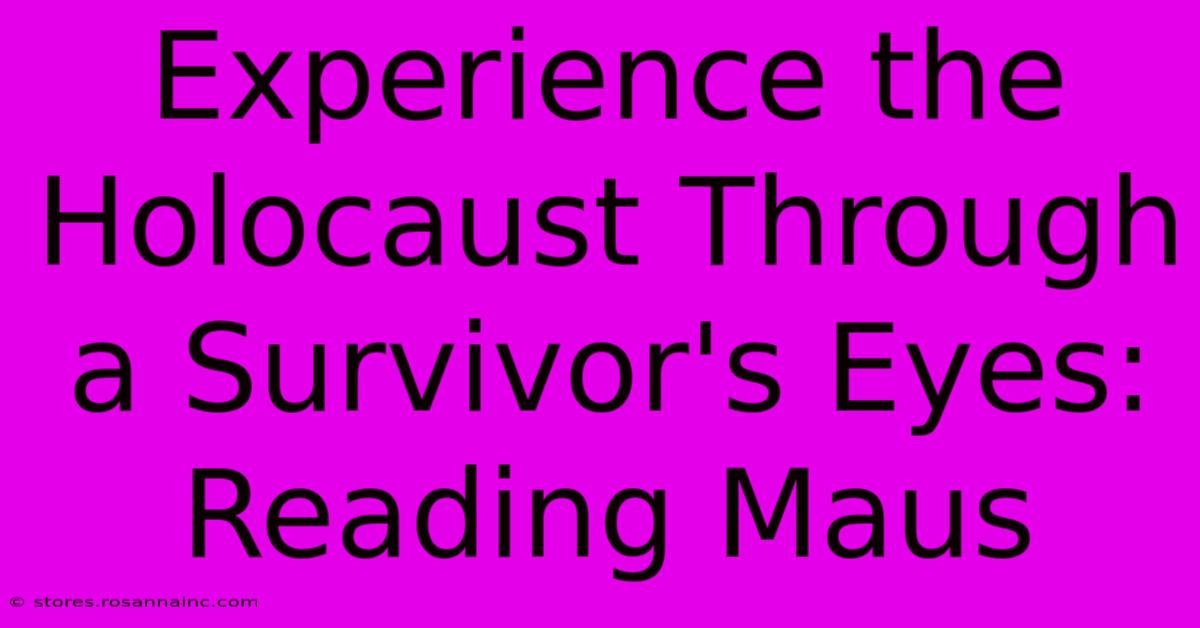Experience The Holocaust Through A Survivor's Eyes: Reading Maus

Table of Contents
Experience the Holocaust Through a Survivor's Eyes: Reading Maus
Art Spiegelman's Maus isn't just a graphic novel; it's a harrowing, unforgettable journey into the heart of the Holocaust. Through a poignant blend of narrative and illustration, Spiegelman masterfully weaves together his father Vladek's experiences in Nazi-occupied Poland with his own struggles to understand his father's trauma and legacy. Reading Maus isn't simply about learning history; it's about confronting the enduring human cost of genocide and the complex relationship between parent and child.
A Unique Narrative Structure: History Told Through Comics
The genius of Maus lies in its unconventional storytelling. Spiegelman uses animals to represent different nationalities – Jews are mice, Germans are cats, and Poles are pigs. This seemingly simplistic choice adds layers of meaning. It allows for a degree of emotional distance, enabling readers to confront the horrific events without being overwhelmed by the sheer brutality. Simultaneously, the anthropomorphism of the characters creates a surprisingly effective emotional connection, allowing readers to empathize with the characters' suffering on a human level, despite their animal representations.
More than just a history lesson:
Maus isn't a dry recitation of historical facts. It's a deeply personal exploration of family, memory, and the intergenerational trauma of the Holocaust. The narrative shifts between Vladek's experiences in the concentration camps and Spiegelman's present-day interviews with his aging father. This creates a dynamic tension between past and present, highlighting the lingering impact of the Holocaust on subsequent generations. The reader witnesses the emotional toll of the Holocaust, not only on the survivors but also on their children and grandchildren.
Facing the Brutality: The Horrors of the Camps
The graphic novel doesn't shy away from depicting the horrors of Auschwitz-Birkenau and other concentration camps. Spiegelman's stark illustrations convey the brutality and dehumanization experienced by Jews, illustrating the systematic extermination carried out by the Nazis. The stark black and white panels, interspersed with moments of unexpected levity, create a jarring yet powerful contrast. This highlights the resilience of the human spirit in the face of unimaginable suffering. The graphic depiction, while difficult to confront, is crucial to understanding the full extent of the atrocities.
Understanding the Psychological Impact:
Maus goes beyond the physical horrors, delving into the psychological scars left by the Holocaust. Vladek's character embodies the survivor's guilt, his anxieties, and his struggle to rebuild his life after the war. Spiegelman, through his own narrative, explores the challenges of understanding his father's trauma and the impact it has had on their relationship. This makes the graphic novel relatable; it shows how trauma transcends generations. The text forces readers to examine the psychological impacts of unimaginable horror.
The Legacy of Maus: A Must-Read for Understanding History
Maus remains relevant decades after its publication. It stands as a powerful testament to the enduring legacy of the Holocaust and the importance of remembering the past. The graphic novel’s innovative approach to storytelling makes it accessible to a wide audience, prompting discussions about history, trauma, and the power of art to convey complex truths. It's a compelling read for anyone seeking to understand this critical period in history and the profound impact it continues to have on the world. It’s a powerful tool for educating and fostering empathy, ensuring the victims' stories are never forgotten.
Why Maus is essential reading:
- Unique Narrative Style: The animalistic representation is both innovative and effective.
- Personal and Emotional: The story transcends historical facts, delving into the emotional impact on individuals and families.
- Powerful Illustrations: The graphic style effectively conveys the brutality and suffering while maintaining a level of emotional distance.
- Intergenerational Trauma: Maus explores the lasting consequences of the Holocaust on subsequent generations.
- Important Historical Document: It serves as a powerful reminder of the horrors of the Holocaust and the importance of remembrance.
By understanding the historical significance and the power of Spiegelman's storytelling technique, readers gain a profound and emotional understanding of the Holocaust, making Maus a critical addition to any exploration of this pivotal moment in history.

Thank you for visiting our website wich cover about Experience The Holocaust Through A Survivor's Eyes: Reading Maus. We hope the information provided has been useful to you. Feel free to contact us if you have any questions or need further assistance. See you next time and dont miss to bookmark.
Featured Posts
-
Clemson Fans Shower Vitale With Love
Feb 09, 2025
-
What Age Is First Grade The Definitive Guide
Feb 09, 2025
-
Who Was Raymond Robinson Green Man The Truth Revealed
Feb 09, 2025
-
Unlocking Insights With Pointwise Mutual Information
Feb 09, 2025
-
Beyond The Numbers The Story Of Nate Silver
Feb 09, 2025
